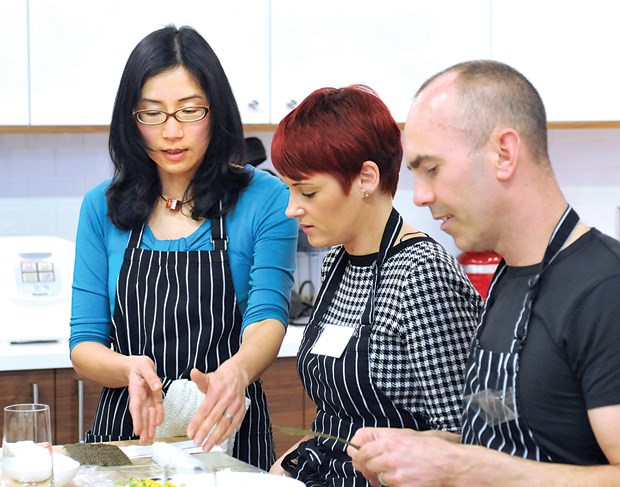The satisfaction of a job well done notwithstanding, I have long maintained that there are certain dishes that are simply not worth the effort of preparing at home when someone else can do it better and for less money.
Pho, for example, is most certainly one of these dishes. By the time you buy beef bones for roasting, create a deep broth over the course of eight or more hours, skim, strain and season that broth perfectly, prepare rice noodles, then add various cuts of beef (brisket, rare flank, tendon, tripe, etc.), basil, sprouts, lime, hoisin sauce and sriracha, you have expended 10 times the effort and spent four times the cost of simply heading down to the local Pho emporium and buying a large bowl to take out.
Sushi is another food about which I have felt this way. I defy you to visit your local fish shop and pick up a variety of sashimi-grade fish and other seafood, then prepare and season your own rice, ready your nori (seaweed sheets) and bamboo mat, chop your various garnishes and fish accompaniments for nigiri and maki, form these fussy, delicate little morsels and still feel like you got better value for your effort than if you had simply popped by Hamaei, Yohachi, Ki Isu or another of the North Shore's excellent sushi restaurants and let the experts prepare your meal for you. Despite having a lot of fun trying my hand at preparing sushi in the lovely new Cook Culture culinary instruction space on Lonsdale Avenue at 12th Street, I am still not entirely sure that I would attempt sushi myself again. While the instruction was excellent and informative, my in-class efforts seemed to me oafish and clumsy, my rolls were triangular instead of round, and I couldn't help but think of the excellent documentary, Jiro Dreams of Sushi, about the Michelin-starred, Tokyo-based sushi master, Jiro Ono, and his lifetime quest for culinary perfection. If Jiro dreams of sushi, my creations would surely be the stuff of his nightmares.
I joined 11 other sushi enthusiasts on a recent Friday evening for a three-hour crash course in the art of sushi production. The course was led by Kimiko Suzuki, a Japanese home cooking enthusiast and natural, affable instructor who guided us through the creation of eight traditional dishes including maki (sushi rolls), nigiri (what most people think of when they hear the word sushi, the little mounds of seasoned rice topped with bite-sized cuts of fish, egg, tofu or vegetables), sushi cones, tomago (Japanese-style omelette), tofu pouches, basic dashi (the seaweed and bonito soup stock that forms the basis of many other dishes) and miso soup.
Cook Culture, which seems to be the overarching brand for the Cook Works retail stores and cooking school, runs a series of cooking courses at the back of their Lonsdale shop. The instructional space is truly top notch, with three long, modern and pristine communal workstations set up around a central kitchen equipped with everything you need to execute high quality dishes. The space wouldn't be out of place on a TV cookery show and is, in fact, outfitted with an overhead video camera that projects the instructor's every move on a giant LED television so that students don't miss a step.
Instruction is very hands-on and each of us in the class was guided through the creation of our various dishes by Suzuki and a team of knowledgeable, helpful Cook Culture volunteers who ensured we had the requisite tools to realize our recipes.
My most successful dish was an inside-out maki of cucumber, pickled daikon, radish sprouts, mango and smoked salmon, this latter sourced locally from Masa's Salmon Smokehouse. The roll was relatively stable (read: it didn't fall into a million bits when I picked it up), pretty in its contrasting and bright yellows, oranges and greens, and tasted like something I might actually have paid for at a restaurant. My one complaint about this effort was the same one I have levied countless times against sushi restaurants: the roll was simply too big and cumbersome to be considered bite-sized. More than ever I now appreciate the discipline and artistry involved in the creation of delicate, manageable morsels of sushi; it is no mean feat to pack a lot of ingredients and flavours into a small and elegant bite.
Almost worth the price of admission on its own was witnessing how tomago, the wonderful, multi-layered and flavourful Japanese take on the humble omelette, is created. A specialized square frying pan is used to cook scrambled eggs, about two at a time, into a square shape by allowing a thin layer of egg to nearly cook through before being folded into a corner of the pan. Each subsequent portion of egg is prepared this way and folded atop the previous layer, resulting in a compact but fluffy rectangle of beautifully cooked, slightly browned, distinctly geometric omelette that can then be seasoned, sliced and, in the case of my course, used to create a lovely assortment of nigiri.
In addition to sushi basics, Cook Culture leads classes in knife skills, rustic Italian cuisine, Izakaya fare, cooking with grains and legumes, French bistro fare, and a number of other disciplines. A second set of classes run in Victoria. My three-hour sushi instruction, which included eating each of the courses I prepared, was $85 plus tax. cookculture.com
Chris Dagenais served as a manager for several restaurants downtown and on the North Shore. He can be reached via email at [email protected].



